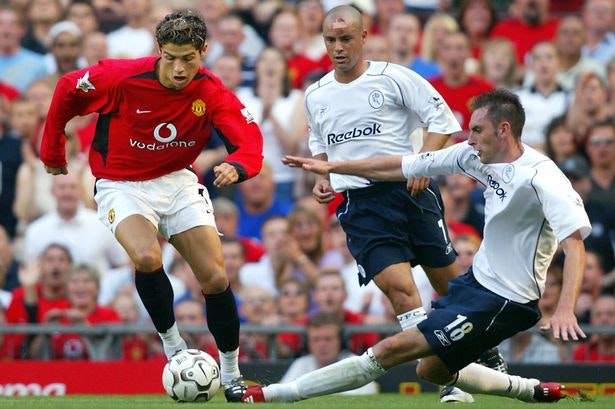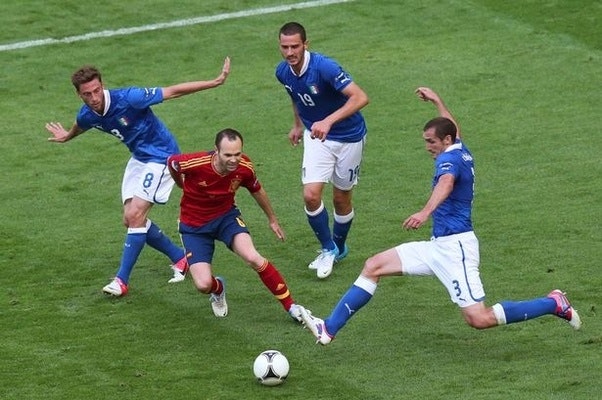This article is an analytical expose of skill moves. Flashy turns and sudden flicks look good on the screen, but why aren't they more popular at the highest level? Is it the mark of a good player to pull off a gaspy stunt in the middle of a high-pace game or is it just immature?
In this article, I will attempt to carefully sift through what makes a skill move effective in a game. To do that, I will define skill moves, explain what I want out of a player in a game, and in the end, give you my opinion on what is the toughest move to defend against.
Introduction
Consider a defensive transition,
1: A
defensive transition is a phase of play where the team doesn't have possession of
the ball and are looking to recover
it by various means.
each player of the team is now responsible either for defending a
pocket of space
(usually behind them) or for marking an opponent. During this transition, if an
opposition player were to break away
from their defender into space, it will throw the entire setup into disarray.
2: The basic idea is
that defenders leave their posts to close down the runaway attacker. This opens
spaces for other
attackers and leaves the goal vulnerable.
Understanding the above scenario is
crucial as it will help us understand what we mean by a skill move, and how it is
different from other ways of knocking
the ball into space by beating defenders.
In football, there are two major categories of defenses, zonal marking and man-marking. In zonal marking, the focus is on the team-mates' positions and the ball whereas in man-marking, the focus is on an opponent. To counter these defensive techniques, teams try to do something called as dismarking where they "shake off" the defence, create space, and open up passing lanes towards the goal.
We will not focus on team dis-marking tactics in this post, where groups of players work together to get past defences. As such, we will not cover rotations and 3rd man techniques like layoffs, passes, and basic one-twos. What we will focus on are individual efforts at dis-marking, and the different methods (often creative) that players employ to achieve this.
What is a skill move?
For the rest of this article, a skill move is the employment of a false or double movement in order to trick the defender into moving one way and exiting in another direction. The definition keeps things simple, and while there are many skills that don't fit into this category, this serves as a good starting point.
A false movement is one that makes the defender think that the attacker is moving one way while the attacker has only "faked" the move. A double movement is a fast trick that makes the ball or the player move to a direction while waiting (hoping?) for the defender to commit. After the defender takes the bait, the attacker deftly goes the other way.
Effectiveness vs. flashiness
Some tricks are crowd pleasers, some tricks are so mundane that they're not considered skill moves in modern football. If you have applied to an academy or have been to football trials anytime, your chances of selection will not be boosted by your ability to perform tricks with the ball unless you get the basics right. This is true while training for a game too, the coach and the rest of the team are not asking you to show a few trick moves per game and head home.
The handshake is unnecessary. There is no need for your skill move to do anything other than beat the defender, and create more attacking options for your team. If you are an up and coming winger trained in the school of street football, you might not like this view, but it is the truth. Effectiveness beats flashiness, but the best of the best make sure that their effective tricks are also worthy of generating a million views on YouTube.
Change in player direction
Skill moves that involve a change in player direction are some of the best tricks that we have seen. The shoulder drop, body-feints, receiving a pass while facing the wrong direction to fool the marker, step-overs and many others are examples of skills that use the attacker's body to send the defender the wrong way. While the shoulder-drop and fake shot get more effective as you get closer to goal, the others work almost anywhere else on the field.
Good midfielders master this art of deception by learning to receive the ball in an angle
that makes it look like they
are doing something, while they are actually waiting for the marker to commit and go the
other way.
3:
Toni Kroos’ Signature Move -
The Kroos Shuffle
Stepovers come
close to being the best skill to have in your arsenal with the fast feet compounded with
the indecision making it a
headache for defenders to counter. Wingers have been employing the stepover to great
success since Brazilians like
Robinho, Ronaldo and Ronaldinho, but the technique has gained popularity in the last
decade and a half thanks to
Cristiano Ronaldo
4:
Google Search lists one of Cristiano's nicknames as "The Sultan of The Stepover".
who might be the player that got the most out of it.
Change in ball movements
The skills involving sudden ball movements are signatures of technically gifted players. These skills are sure-shot effective when done right but usually lead to loss of possession. Andres Iniesta comes to mind with his deft two-touch and release being one of the most elegant ways to get past a defender. Backheels and chops are some of the most aesthetically pleasing skills to watch out for but they are waning in popularity because of how much speed you need to carry while doing them. Other skills are the elastico, and tricks in the air. Neymar is a player who relies a lot on moving the ball off the ground to get past defenders and while the moves are effective, they don't get a lot of recognition as they're seen as flashy.
How to identify good skill moves
Now we don the hat of an analyst, are there skill moves which are better than the other? Are there tricks that are better off not used in a game? Should you teach players to learn certain skills and discard the others?
The answer to all the questions above is yes. One good rule of thumb is that simple moves are better, because every second on the ball drains player energy, and you don't want a game where one player has the ball for too long. These stats are glorified, but it is usually the mark of a team close to ruin. All skill moves drastically increase in effectiveness with closeness to goal. The reasons are simple, the stakes are higher, and the pressure cracks the less experienced.
How to defend against a skill move
In general, a good defender is the one that slowly squeezes the game out of the attacker. You have to be a player that gives no time for the attacker to think and to get into space. While this requires you to be tireless, you shouldn't just run around the attacker and call yourself an intense defender.
Defend either the man or the ball, but do not defend both. Move the attacker into congested areas, get the attacker to shift the ball to their weaker foot and don't lunge for the ball at the first opportunity. The best defenders commit to the tackle as late as they can while "suffocating" the attacker all the time.
Why nothing beats the body feint
The body feint follows a simple rule: pretend to do one thing and do something else. If done right, the defender takes the bait and opens up a some space or gives you some more time. Football is littered with feints, the sudden stop of the ball while the defender runs off into the crowd, the offside trap, and many more.
The body feint works the best because the defender has spent the entire game building
up
expectations, and the attacker
has helped by repeating the false movement to prime the defender. It combines the most
effective techniques while
managing to look impressive. A research team at Norway even analyzed the effectiveness
of body feints.
5:
Aggerholm, Kenneth & Jespersen, Ejgil & Ronglan, Lars. (2011). Falling For The Feint
– An Existential Investigation Of A
Creative Performance In High-Level Football. Sport Ethics and Philosophy. 5.
343–358. 10.1080/17511321.2011.602589.
How to learn skill moves
The best way to learn skill moves is to try them out on the pitch. A major beginner mistake is to do lots of drills during practice and in their backyard but not implementing them in the game. Failure rate will be high initially, and your teammates will get tired of seeing you lose the ball all the time but that is the cost of getting better.
Try out the body feint and the stepover the next time you go out to play and try to understand why you couldn't pull it off. Was your touch too heavy? Did the defender see through your pretense? Were you too slow to react? And watch out for fouls!
Conclusion
I have not talked about some very unusual skill moves in this post, for example, the rabona has always been an enigma to me. There is no clear reason why it's useful but in front of goal, when everyone's expecting a shot or a pass from your weak foot, it can help if you can hook the ball into goal. The pirouette is another famous one, which is a combination of a player movement and a ball movement.
For all this talk about skills and tricks, the number of skill moves in a game is usually in the single digits. A good activity for the reader is to pick any game from top-flight football and count the number of times a player successfully got away with a trick. The numbers look bad and I guess that the reason is because managers prefer to not get their teams in positions where a single mistake can change the game.
Is that a good thing or a bad thing?
1: A defensive transition is a phase of play where the team doesn't have possession of the ball and are looking to recover it by various means.
2: The basic idea is that defenders leave their posts to close down the runaway attacker. This opens spaces for other attackers and leaves the goal vulnerable.
3: Toni Kroos’ Signature Move - The Kroos Shuffle
4: Google Search lists one of Cristiano's nicknames as "The Sultan of The Stepover".
5: Aggerholm, Kenneth & Jespersen, Ejgil & Ronglan, Lars. (2011). Falling For The Feint – An Existential Investigation Of A Creative Performance In High-Level Football. Sport Ethics and Philosophy. 5. 343–358. 10.1080/17511321.2011.602589.
Published: July 21, 2021
Updated: July 21, 2021
Status: Finished

